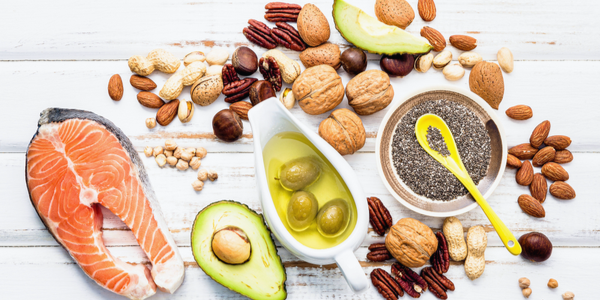
Thanks to the hundreds of different versions of the same low-carb diet and especially keto, fats are not quite the pariah they once were in the eighties and nineties. Nonetheless, they are still quite misunderstood.
Fats can actually be categorized in various ways, the two most typical being by their chain length or number of double bonds. This article ventures into the latter, explaining the differences between saturated versus unsaturated fat and how to include both in a healthy diet.
The Function of Fat
In general, most fat molecules play similar roles within the human body. Whereas carbohydrate's main role is to provide energy and protein works to grow, develop and repair tissue, fat's main functions include:
• Make hormones
• Insulation/temperature regulation
• Cushion organs and tissues
• Long term source of energy
• Provide structure to cell membranes
• Carry and store fat-soluble nutrients
• Increase satiety and reduce carb cravings
Amongst the categories, specific types of fat exert slightly different roles. These include short, medium, and long-chain fatty acids:
• Short-chain fatty acids serve as fuel for good bacteria in the colon
• Medium-chain fatty acids can be quickly digested and converted into ketones
• Long-chain fatty acids take longer to digest and are most commonly broken down into usable energy.
The slightly different functions of saturated and unsaturated fat are discussed below.
Fat was previously to blame for the obesity epidemic and surge in heart disease. However, research from the last 20 years reveals it is not so much the quantity of fat that is the problem but the quality or type of fat that makes a large difference. Interestingly, the quality is largely determined by the fat's structure, as are carbs and protein to some extent.
Nowadays, eating nutrient-dense "healthy" fat from sources like unrefined olive oil, avocados, unprocessed nuts and seeds, and others are associated with:
• Decreasing inflammation and liver fat
• Better heart and brain health
• Improved insulin sensitivity and blood sugar regulation
• Weight management
• Balanced hormone levels
Again, gaining such benefits mostly comes down to the quality and type of fat.
Saturated Versus Unsaturated Fat
The difference between saturated and unsaturated fats is the number of double bonds in their fatty-acid chain.
Saturated Fats
Saturated fats lack double bonds between carbon atoms while unsaturated fats have one or more double bonds in their fatty-acid chain. Though there are exceptions, most saturated fats are derived from animal products and tend to be solid at room temperature, while unsaturated fats come from plants and are usually liquid at room temperature.
Previous dietary recommendations suggested saturated fat was harmful to health. However, this has evolved in recent years due to studies showing insufficient evidence to correlate diets high in saturated fat with heart disease like was formerly believed.
Even more importantly, an overarching amount of research demonstrates that reducing saturated fats only benefits health when replaced with unsaturated fats and not carbohydrates. Nonetheless, eating too much saturated fat is associated with raising cholesterol, thus it is recommended to eat no more than 15 to 25 grams per day. This also means that eating dietary cholesterol, like the yolk of an egg, is not linked to hypercholesterolemia, a long-held myth.
Unsaturated Fats: Monounsaturated Fat
Furthermore, unsaturated fats can be further categorized as monounsaturated, polyunsaturated and trans fatty acids.
Like the name suggests, monounsaturated fats have one double bond in their structure. Research shows that the consumption of plant-based monounsaturated fats can help decrease the risk for cardiovascular disease and increase longevity.
Omega-9 fatty acids are a type of monounsaturated fat that is less discussed because the body can form this type of fat. Based on unsaturated definition, omega-9 fatty acids are monounsaturated, meaning they only have one double bond.
Still, research associates these fatty acids with decreased inflammation and improved insulin sensitivity, thus, should also be included in a healthy diet. Sources include olive oil, cashews, almonds, peanuts, and walnuts.
Unsaturated Fats: Polyunsaturated Fat
Polyunsaturated fats have more than one double bond and cannot be made from the body, thus, must be obtained from nutrition.
Now, polyunsaturated fats are further divided into omega-3 and omega-6 fatty acids. Omega-3 fatty acids are the highly touted fats associated with exemplary brain and heart health. The most common and nutrient dense ones include eicosapentaenoic (EPA), docosahexaenoic (DHA), and alpha-linoleic acid (ALA).
The first two examples are the stars of many fish oil supplements and the latter can be converted into EPA or DHA, though the process is quite inefficient. All of these are considered essential fatty acids, meaning they must come from dietary sources because the body cannot naturally produce them.
On the other hand, omega-6 fatty acids are more controversial due to their potential inflammatory role. The most common omega-6 fatty acid is linoleic acid which can be converted into arachidonic acid (AA). Like EPA, AA produces eicosanoids, but they are proinflammatory and linked to raising the risk of heart disease. Some studies show that heating (cooking) vegetable oils (high in omega-6 fatty acids) decreases their antioxidant activity and increases free-radical production (which causes inflammation).
Omega-6 fatty acids are not inherently bad for health, but many people simply over-consume and heat these fatty acids and do not eat enough omega-3 fatty acids to balance them. Equally important, an abundance of research shows omega-6 fatty acids do not exert any negative health effects when consumption of omega-3 fatty acids is proportionally higher.
Basically, focus on including plenty of omega-3 fatty acid foods, and consume less omega-6 fatty-acid foods.
As will be evident, many sources of fat include more than one type of fatty acid. Rarely does a fat source only include one type, and many foods are composed of saturated and unsaturated fat.
Unsaturated Fats: Trans Fat
The third type of unsaturated fat, trans fat, is commonly associated with negative health outcomes. Unbeknownst to many, trans fats can be formed naturally when bacteria in animals like cattle, sheep, and goats digest grass. The most common one is known as conjugated linoleic acid found in dairy fat, is marketed as healthful, and comes in supplemental form for health purposes.
On the other hand, artificial man-made trans fat, otherwise known as partially hydrogenated fat, incurs negative health consequences. Clinical studies correlate artificial trans fat with heart disease, high LDL (bad) cholesterol, and low HDL (good) cholesterol levels.
Trans fat is also associated with greatly increasing systemic inflammation. While the mechanism is not fully understood, they play a role in poor glucose metabolism and insulin resistance, thus increasing the risk of diabetes. Finally, trans fats are also implicated in some cancers, especially colon.
The most common source of trans fat is partially hydrogenated vegetable oils. Thankfully, the FDA actually banned the use of these oils in most processed foods. However, the ban has not been fully implemented yet, so many processed and packaged foods still contain this poor fat.
Examples of Different Fats
Whether from plants or animal sources, fats are found in a wide variety of foods. Some are more healthful than others, and common examples include those categorized and listed below.
Examples of Saturated Fat:
• Butter, ghee, and lard
• Coconut oil, cream, and milk
• Palm oil
• Cakes, biscuits, and other pastries
• Fatty cuts of meat
• Cured meats like bacon, sausage, salami, and pepperoni
• Cheese and other full-fat dairy
• Milk chocolate
Examples of Trans Fat:
• Vegetable shortening
• Hydrogenated vegetable oils
• Some microwave popcorn varieties
• Margarine
• Fried fast foods like chicken tenders, battered fish, hamburgers, fries, and fried noodles
• Baker products like donuts and cakes made from vegetable shortening or margarine
• Non-dairy coffee creamers/coffee whiteners
• Some potato and corn-based chips and crackers
• Pie crusts
• Pizza dough
• Canned frosting
Examples of Monounsaturated Fat:
• Unrefined, extra virgin olive oil
• Almonds
• Cashews
• Pistachios
• Peanuts
• Olives
• Pumpkin seeds
• Avocados
• Sunflower seeds
• Eggs
• Pork
Examples of Polyunsaturated Fat:
Omega-3 Fatty Acids
• Fatty fish like salmon, sardines, seabass, trout, and mackerel
• Oysters
• Shrimp
• Seaweed and algae
• Chia, hemp, and flax seeds
• Walnuts
• Edamame
• Kidney beans
• Unrefined soybeans
• Fish oil, cod liver oil, krill oil, and algae oil
Omega-6 Fatty Acids
• Evening primrose oil
• Borage oil
• Refined vegetable oils (corn, soybean, canola, grapeseed)
• Foods cooked in refined vegetable oils
• Soybean oil
• Mayonnaise
• Walnuts
• Sunflower seeds
• Almonds
• Cashews
In Summary
Fat is a very complex and diverse macronutrient associated with beneficial health outcomes when consumed in appropriate amounts and ratios. It can be categorized in a variety of ways but bond saturation is the most typical classification.
Whereas saturated fats have no double bonds in their structure, unsaturated fats have one or more double bonds, and the placement of these bonds determines whether it is an omega-3, 6, or 9 fatty acid.
• Essential omega-3 fatty acids are most frequently associated with heart, brain, and metabolic health. They are found in large quantities in wild-caught fatty fish, sea veggies, and some nuts and seeds.
• Omega-6 fatty acids also positively contribute to health but become proinflammatory when consumption of them outweighs omega-3 intake. Refined vegetable oils are the most inflammatory sources while nuts and seeds sources provide benefit.
• It is smart to include some omega-9 fatty acids in the diet even though the body can produce these naturally and to avoid artificial trans fat altogether.
Fats are an essential part of the diet and reduce the risk of many typical chronic diseases when high-quality sources are consumed in moderation and proportionally balanced amongst the different types.
References:
Coyle D. 7 Foods That Still Contain Trans Fats. Healthline. Published October 29, 2018. https://www.healthline.com/nutrition/trans-fat-foods.
How To Eat Less Saturated Fat. NHS. Reviewed March 26, 2020. www.nhs.uk/live-well/eat-well/eat-less-saturated-fat/.
Pietrangelo A. Saturated vs. Unsaturated Fat: Know the Facts. Healthline. Updated December 11, 2019. www.healthline.com/health/food-nutrition/saturated-vs-unsaturated-fat.
Robertson R. Omega-3-6-9 Fatty Acids: A Complete Overview. Healthline. Updated October 22, 2020. www.healthline.com/nutrition/omega-3-6-9-overview#food-sources.
Robertson R. What Are the Benefits of Monounsaturated Fats? Healthline. Published September 19, 2017. www.healthline.com/nutrition/monounsaturated-fats.







